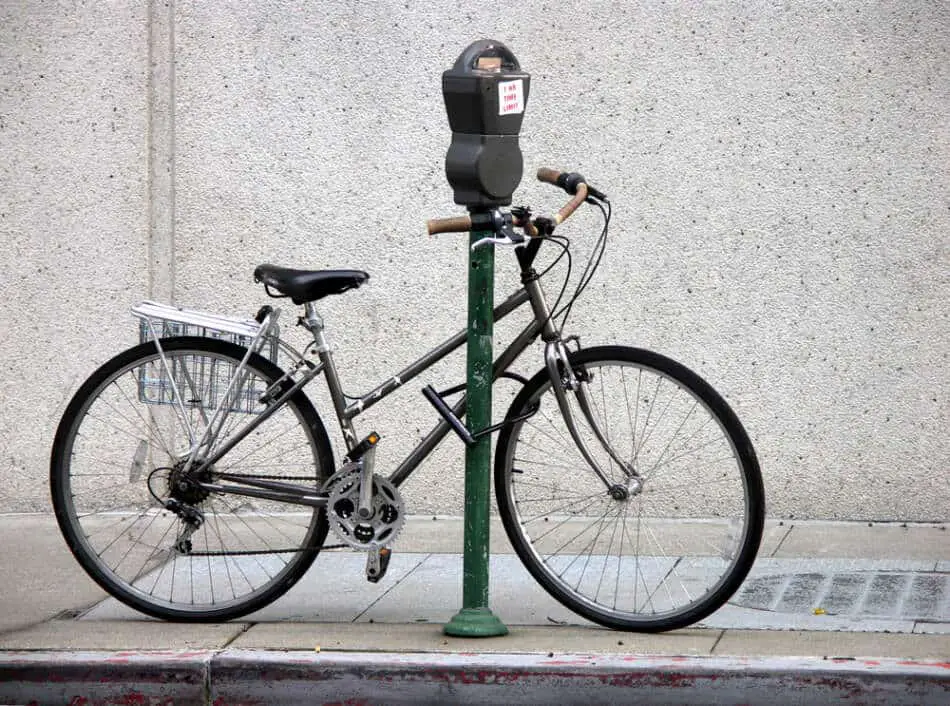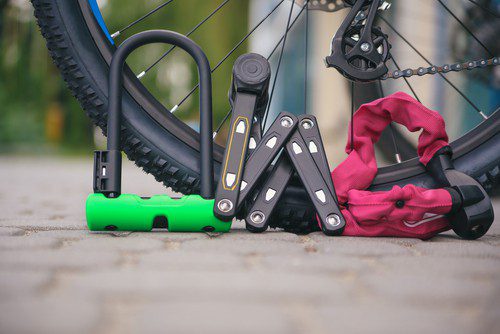So, you just purchased your own bicycle, or perhaps you have decided to start taking your bike to destinations around town. Either way, the most important investment you should make for it after safety equipment is a quality lock. But unless you want your new hobby to be stolen and be stranded, you need to buy a lock that properly fits your bike.
A bicycle lock needs to be long enough to at least wrap snugly around
- A wheel
- Part of the frame
- An immovable object
Keep reading for additional advice and best practices on keeping your bicycle safe at all times. After all, choosing a bike lock can be more complicated than you think.
Making Sure Your Bike Lock Fits
How big is that exactly? It depends on a few qualifiers like:
- Correct usage
- Size of the bike
- What you will be attaching it to
- Attached accessories
Correct Usage
Bicycle locks are designed to fit most if not all bikes straight from the factory. Thus, it stands to reason that if the lock seems like it is too long, you might not be attaching it correctly. You might intuitively think the lock can just be wrapped around a wheel and a bike rack or some other street object, like a tree or lamp post. If you have done that, there is a good chance your lock seems way too long.

That is because you are missing the frame. Think about it: most wheels, even with all their spokes and chains, are technically only attached directly to the frame with two nuts and bolts. A thief can very easily unscrew these in less than a minute. He may be missing a wheel, but he can steal one of those from someone else’s bike.
Therefore, it is a good rule of thumb to include a major part of the frame that cannot be worked around by simply taking it off:
- Another wheel
- The seat
- The handlebars
This part is usually rather thick too, meaning a thief would have to spend a lot more timing cutting to release your bike. Not to mention ruin the structural integrity of it as well. You can use the front wheel or back wheel, whichever allows a stronger part of the frame to be involved.
Source: Pure Cycles
Size of the Bike
Usually including those three parts within the lock loop will make it nice and snug. However, you need to keep in mind that not all bicycles are created exactly equal. Even if you follow the correct locking steps above, you may find that your frame is just too wide. Or perhaps you already bought some giant mountain biking tires and have found that your old lock no longer fits.
To avoid spending a bunch of money on a lock that does not fit your bicycle, measure how long it should be. Use the string method like you would for taking body measurements for clothing. Not sure how that would work? Follow these steps:
- First, cut off way more string than you know you will need. Two arm lengths, across your body, will be more than enough. You do not want to be dealing with a whole roll of string.
- Hold one end while feeding the other end through two spokes, around the frame, around the fixed object, and back to the other end.
- Pinch the part of the string that touches the other end. Keep it a little loose, but not dangling.
- Lay the string flat on the floor in a straight line next to a tape measure. Measure how long that string is.
- Perform the same task around the circumference if a lock in a bike shop, or, if online, observe the measurements in the product description.
It is a bit easier than it sounds. If you perform this test, you will know for sure that the bike lock will be long enough to fit your bike, no matter what style and customizations you have.
What You Attach Your Bike To
This measurement becomes especially important depending on where your bicycle will be locked exactly. Let’s face it: bike sizes can vary here and there, but your overall dimensions should never vary by more than a few inches.
On the other hand, location can vary a great deal. Sometimes there are plenty of bike racks at your work or school. However, in plenty of instances, you might need a tree or lamp post. If you are using one of these, a U lock clearly will not do. Even though they are heavy, a chain will be your best bet.
Attached Accessories
Of course, that perfect measurement will do you no good if you accidentally place an accessory in the way. Before you attach a water bottle holder or emergency tire pump, ask yourself if it will interfere with how you lock your bike. Security should be just as important as hydration and full tires. Therefore, if those accessories are going to be in the way, something has to give. See if your lock will fit around the other tire. Or place your accessories elsewhere on your bicycle.
Going the Extra Mile
Besides simply having a lock that fits your bike, here are some other useful tips to consider to keep it secure:
- Buy quality, not cheap
- Add on a steel cable
- Location is more than just the object you are locking to
Buy Quality
All the measurements in the world will not save you from a cheap bike lock. There are some things you need to buy the good stuff for. After all, how much money did that cheap lock really cost you if you need to buy a brand-new bike? Check out one of these good bicycle locks:
- Sigtuna– This heavy-duty U lock is 16 mm wide and comes with an additional steel cable.
- Kryptonite– The name is probably due to its effect on would-be thieves. This solid steel chain lock is a bit pricey but come highly recommended in the bicycle community
- Foldylock– This lock is certainly stronger than it looks. It unfolds to a customizable width, allowing it to fit almost any circumstance. When you are leaving, simply fold it up and put it in your bag.
Add A Steel Cable
A steel cable certainly should not be your only line of defense. However, if you already have a sturdy bike lock, also attaching a steel cable will give you an additional layer of protection. A nice long one like this can wrap around both wheels and your fixed object at the same time, making a thief’s life even more miserable.
Location Is More Than Just Your Fixed Object
Locking your bicycle to a tree is great, but not if it is in a quiet location. If your bike is hidden but still in public, a thief will be able to reach it and have plenty of time to work on it.
Remember, there is safety in numbers. Try instead locking your bike to a rack with lots of other bikes. Hide it randomly in the middle. The less it sticks out from the crowd, the less desirable it will seem. If you use this method and your bicycle is secured in place, the thief will surely go to an easier bike instead.
In addition, lock your bicycle in a spot under a camera if at all possible. That way there is video evidence if it is stolen. A camera just being there usually causes thieves to think twice anyway, hopefully avoiding your bike being stolen in the first place.
Final Thoughts
Having a bicycle is an awesome way to get exercise and to get around town while being friendly to the environment. However, you need to be able to keep your bike safe while you’re not using it. Choosing the best bike lock is key to keeping your bike safe from prying hands.
Other articles of interest:
5 Best Bicycle Covers for Storage
3 Best Methods To Store Your Bike at Home
How To Store Bike Tires Without Damaging Them

